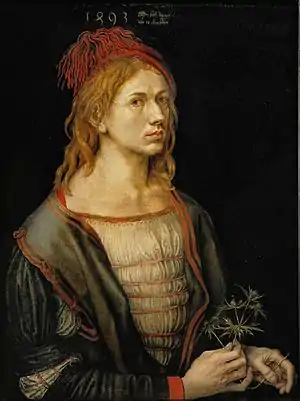Portrait of the Artist Holding a Thistle
Portrait of the Artist Holding a Thistle (or Eryngium) is an oil painting on parchment pasted on canvas by German artist Albrecht Dürer. Painted in 1493, it is the earliest of Dürer's painted self-portraits and has been identified as one of the first self-portraits painted by a Northern artist.[1] It was acquired in 1922 by the Louvre in Paris.[2]
| Portrait of the Artist Holding a Thistle | |
|---|---|
 | |
| Artist | Albrecht Dürer |
| Year | 1493 |
| Type | Oil on vellum (transferred to canvas ca. 1840) |
| Dimensions | 56.5 cm × 44.5 cm (22.2 in × 17.5 in) |
| Location | Louvre, Paris |
Dürer looks out at the viewer with a psychologically complex but rather melancholy and reserved, serious minded, facial expression. During the 15th century, thistles were symbols of male conjugal fidelity.[3]
History
In 1493, Dürer was 22 years old and working in Strasbourg. He had completed his apprenticeship with Michael Wolgemut and his tour as a journeyman, and would marry Agnes Frey on 7 July 1494.[4]
The date and the plant in the artist's hand seem to suggest that this is a betrothal portrait (Brautporträt). Dürer has in fact depicted himself in the act of offering a flowering spray identified by botanists as eryngium amethystinum: its German name is "Mannestreue", meaning conjugal fidelity. Resembling the thistle (from which the portrait's title), this umbelliferous plant is used in medicine, and is regarded as an aphrodisiac.[5] It may also have religious significance; the same plant in outline form is inscribed in the gold ground of Dürer's painting Christ as the Man of Sorrows (1493–94).[4]
Dürer was temperamentally inclined to philosophical doubts. He often analysed his own face in drawn or painted effigies – sometimes idealizing it, sometimes not. The lines written beside the date in this painting reveal the philosophical and Christian intention of the work:
Myj sach die gat
Als es oben schtat.
In other words (and liberally): My affairs follow the course allotted to them on high. Marriage has in part determined his destiny – the Bridegroom puts his future life in the hands of God.[6]
In 1805, Goethe saw a copy of this portrait in the museum at Leipzig and described it as of "inestimable value."[7] According to Lawrence Gowing, who calls this "the most French of all his pictures", the Portrait of the Artist Holding a Thistle is singular among Dürer's paintings as "the touch is freer and color more iridescent than in any other picture one remembers".[2]
References
- Fenyő, Iván (1956). Albrecht Dürer. Budapest: Corvina. p. 16.
- Gowing (1987), p. 164
- Brion (1960), p. 127
- Wolf (2006), p. 28.
- Botanical herbal note on the eryngium, on Botanical.com. Accessed 13 January 2012
- J.L. Koerner, The Moment of Self-portraiture in German Renaissance Art, University of Chicago Press (1997).
- H. von Einem, Goethe und Dürer – Goethes Kunstphilosophie, Hamburg: von Schröder (1947).
Sources
- Brion, Marcel. Dürer. London: Thames and Hudson, 1960.
- Gowing, Lawrence. Paintings in the Louvre. New York: Stewart, Tabori & Chang, 1987. ISBN 1-55670-007-5
- Wolf, Norbert. Albrecht Dürer. Prestel, 2010. ISBN 978-3-7913-4426-3
Further reading
- Bailey, Martin. Dürer. London: Phaidon Press, 1995. ISBN 0-7148-3334-7
- Bartrum, Giulia. Albrecht Dürer and his Legacy. British Museum Press, 2002. ISBN 0-7141-2633-0
- Campbell Hutchison, Jane. Albrecht Dürer: A Biography. Princeton University Press, 1990. ISBN 0-691-00297-5
- Eser, Thomas. "Dürers Selbstbildnisse als 'Probstücke'. Eine pragmatische Deutung". In: Menschenbilder. Beiträge zur Altdeutschen Kunst, ed. by Andreas Tacke and Stefan Heinz, Petersberg 2011, p. 159–176
- Panofsky, Erwin. "The Life and Art of Albrecht Dürer", Princeton, 1945. ISBN 0-691-00303-3
- Schauerte, Thomas. "Dürer. Das ferne Genie. Eine Biografie". Stuttgart: Reclam, 2012.
- Schmidt, Sebastian: "„dan sӳ machten dy vürtrefflichen künstner reich“. Zur ursprünglichen Bestimmung von Albrecht Dürers Selbstbildnis im Pelzrock". In: Anzeiger des Germanischen Nationalmuseums 2010, p. 65–82.
External links
| Wikimedia Commons has media related to Albrecht Dürer. |
.jpg.webp)